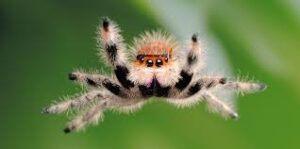Understanding the Lifespan of Jumping Spiders
Jumping spiders, with their remarkable agility and captivating behaviors, are among the most intriguing of arachnids. While their striking appearance and fascinating hunting techniques often steal the spotlight, one aspect that is equally interesting is their lifespan. How long do these tiny predators live, and what factors influence their longevity?
Average Lifespan of Jumping Spiders

In the wild, the average lifespan of a jumping spider ranges from six months to two years. However, under optimal conditions in captivity, some species can live up to three years. The lifespan of a jumping spider is influenced by various factors, including species, environment, diet, and whether they live in the wild or in captivity.
1. Wild vs. Captive Lifespan
- Wild: Jumping spiders in the wild face numerous challenges, including predators, scarcity of food, and environmental hazards. These factors can shorten their lifespan. In their natural habitat, their life expectancy tends to be on the lower end of the spectrum, often around six months to one year.
- Captivity: In a controlled environment, jumping spiders are shielded from many of the threats they face in the wild. With a consistent supply of food, protection from predators, and stable environmental conditions, these spiders can live longer, sometimes up to three years.
2. Gender Differences in Lifespan
Typically, female jumping spiders tend to live longer than their male counterparts. This is partly because males often engage in risky behaviors, such as searching for mates and competing with other males, which can decrease their lifespan. Females, on the other hand, may live longer as they tend to stay in safer areas, especially when guarding their eggs.
Factors Affecting Lifespan

1. Species Variation
The lifespan of jumping spiders can vary significantly between species. For example, common species like the Bold Jumping Spider (Phidippus audax) and the Zebra Jumping Spider (Salticus scenicus) may have similar lifespans, while more exotic species like the Peacock Jumping Spider (Maratus volans) might have different life expectancies due to their unique environmental and biological needs.
2. Environmental Conditions
- Temperature and Humidity: Jumping spiders thrive in environments with stable temperatures and appropriate humidity levels. Extreme temperatures or dry conditions can lead to stress and a shortened lifespan.
- Habitat: Whether a spider lives in an urban garden, a forest, or a meadow, the availability of food and shelter plays a crucial role in its survival. A well-maintained habitat in captivity that mimics the spider’s natural environment can extend its lifespan.
3. Diet
A consistent and nutritious diet is vital for the health and longevity of jumping spiders. In the wild, these spiders feed on a variety of insects, relying on their excellent vision and jumping ability to catch prey. In captivity, providing a steady supply of appropriate prey, such as fruit flies or small crickets, ensures they receive the necessary nutrients to thrive.
Conclusion
Jumping spiders, with their relatively short yet fascinating lives, offer a glimpse into the complexity of the natural world. Whether in the wild or in captivity, understanding the factors that influence their lifespan can enhance our appreciation of these remarkable arachnids. Proper care and attention to their environmental needs can help ensure that pet jumping spiders live as long and healthy a life as possible.




